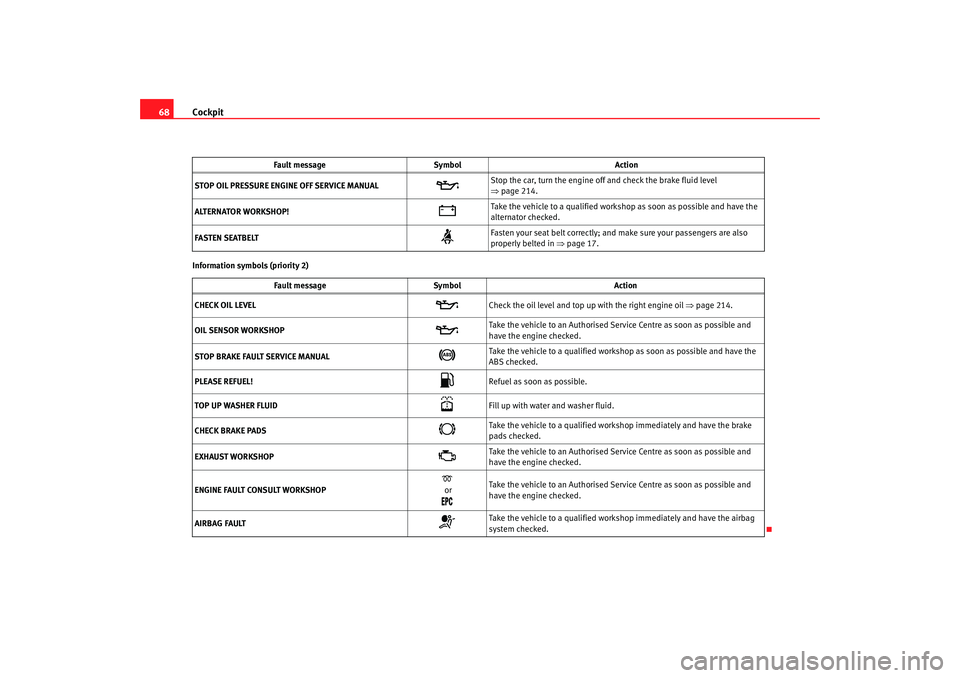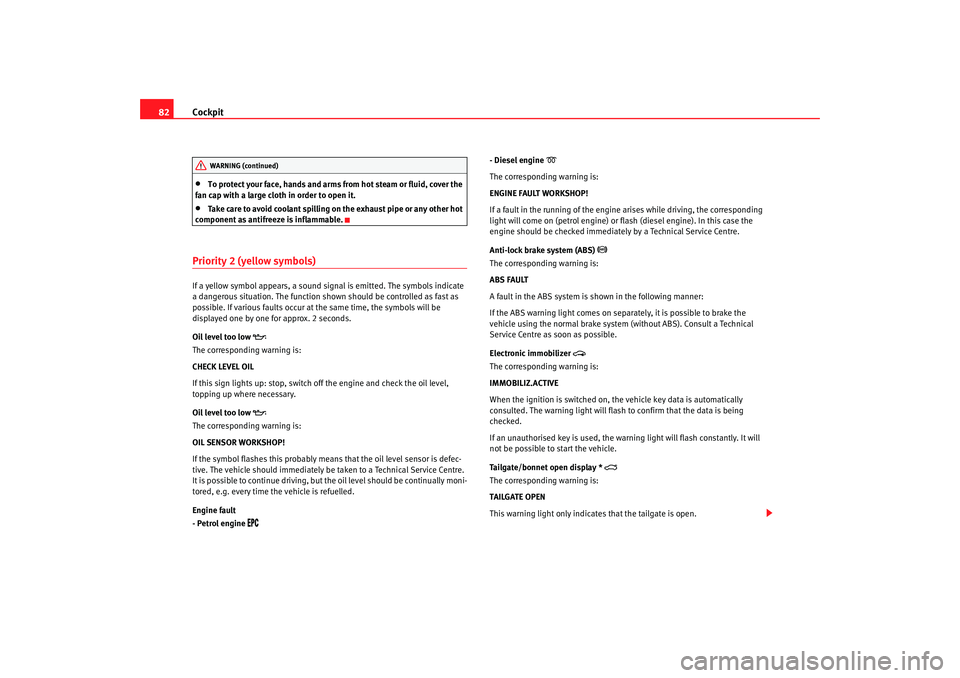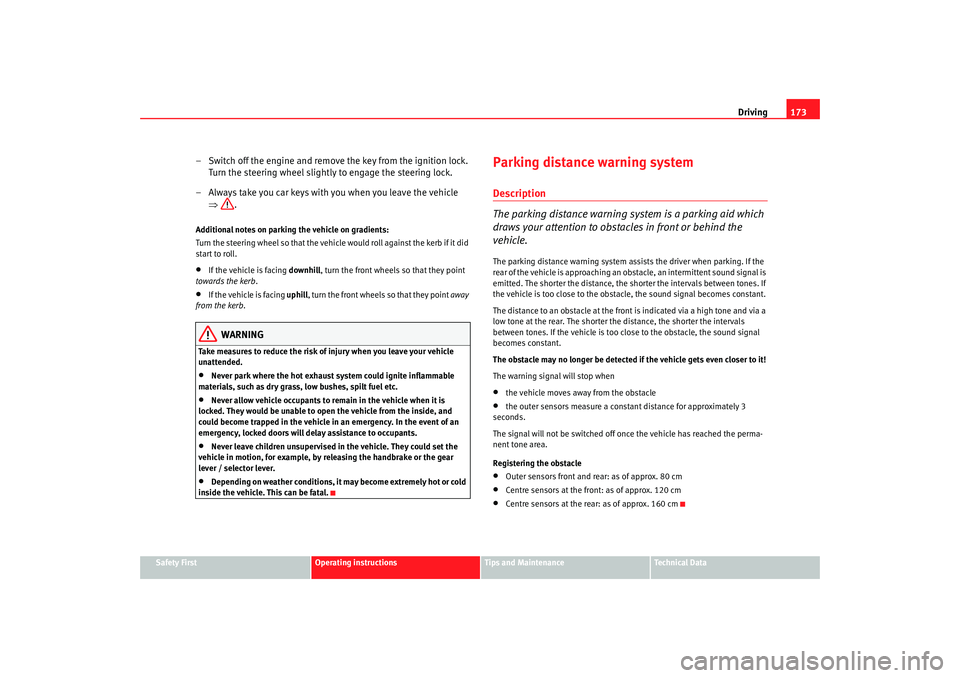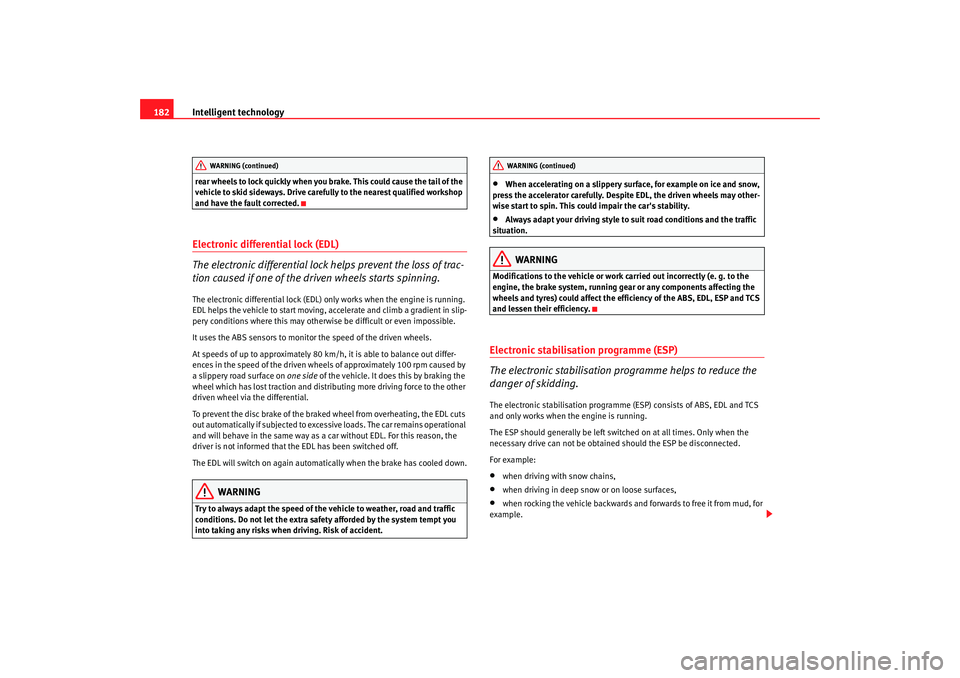brake sensor Seat Alhambra 2007 Owner's Manual
[x] Cancel search | Manufacturer: SEAT, Model Year: 2007, Model line: Alhambra, Model: Seat Alhambra 2007Pages: 291, PDF Size: 9.13 MB
Page 70 of 291

Cockpit
68Information symbols (priority 2) STOP OIL PRESSURE ENGINE OFF SERVICE MANUAL
Stop the car, turn the engine off and check the brake fluid level
⇒page 214.
ALTERNATOR WORKSHOP!
Take the vehicle to a qualified workshop as soon as possible and have the
alternator checked.
FASTEN SEATBELT
Fasten your seat belt correctly; and make sure your passengers are also
properly belted in ⇒page 17.
Fault message Symbol Action
CHECK OIL LEVEL
Check the oil level and top up with the right engine oil ⇒page 214.
OIL SENSOR WORKSHOP
Take the vehicle to an Authorised Service Centre as soon as possible and
have the engine checked.
STOP BRAKE FAULT SERVICE MANUAL
Take the vehicle to a qualified workshop as soon as possible and have the
ABS checked.
PLEASE REFUEL!
Refuel as soon as possible.
TOP UP WASHER FLUID
Fill up with water and washer fluid.
CHECK BRAKE PADS
Take the vehicle to a qualified workshop immediately and have the brake
pads checked.
EXHAUST WORKSHOP
Take the vehicle to an Authorised Service Centre as soon as possible and
have the engine checked.
ENGINE FAULT CONSULT WORKSHOP
or
Take the vehicle to an Authorised Service Centre as soon as possible and
have the engine checked.
AIRBAG FAULT
Take the vehicle to a qualified workshop immediately and have the airbag
system checked.
Fault message
Symbol Action
alhambra ingles.book Seite 68 Donnerstag, 19. April 2007 4:04 16
Page 84 of 291

Cockpit
82•
To protect your face, hands and arms from hot steam or fluid, cover the
fan cap with a large cloth in order to open it.
•
Take care to avoid coolant spilling on the exhaust pipe or any other hot
component as antifreeze is inflammable.
Priority 2 (yellow symbols)If a yellow symbol appears, a sound signal is emitted. The symbols indicate
a dangerous situation. The function sh own should be controlled as fast as
possible. If various faults occur at the same time, the symbols will be
displayed one by one for approx. 2 seconds.
Oil level too low
The corresponding warning is:
CHECK LEVEL OIL
If this sign lights up: stop, switch off the engine and check the oil level,
topping up where necessary.
Oil level too low
The corresponding warning is:
OIL SENSOR WORKSHOP!
If the symbol flashes this probably means that the oil level sensor is defec-
tive. The vehicle should immediately be taken to a Technical Service Centre.
It is possible to continue driving, but the oil level should be continually moni-
tored, e.g. every time th e vehicle is refuelled.
Engine fault
- Petrol engine
- Diesel engine
The corresponding warning is:
ENGINE FAULT WORKSHOP!
If a fault in the running of the engine arises whil e driving, the corresponding
light will come on (petrol engine) or flash (diesel engine). In this case the
engine should be checked immediately by a Technical Service Centre.
Anti-lock brake system (ABS)
The corresponding warning is:
ABS FAULT
A fault in the ABS system is shown in the following manner:
If the ABS warning light comes on separately, it is possible to brake the
vehicle using the normal brake system (without ABS). Consult a Technical
Service Centre as soon as possible.
Electronic immobilizer
The corresponding warning is:
IMMOBILIZ.ACTIVE
When the ignition is switched on, the vehicle key data is automatically
consulted. The warning light will flash to confirm that the data is being
checked.
If an unauthorised key is used, the warning light will flash constantly. It will
not be possible to start the vehicle.
Tailgate/bonnet open display *
The corresponding warning is:
TAILGATE OPEN
This warning light only indicates that the tailgate is open.
WARNING (continued)
alhambra ingles.book Seite 82 Donnerstag, 19. April 2007 4:04 16
Page 175 of 291

Driving173
Safety First
Operating instructions
Tips and Maintenance
Te c h n i c a l D a t a
– Switch off the engine and remove the key from the ignition lock.
Turn the steering wheel slightly to engage the steering lock.
– Always take you car keys with you when you leave the vehicle ⇒ .Additional notes on parking the vehicle on gradients:
Turn the steering wheel so that the vehicle would roll against the kerb if it did
start to roll.•
If the vehicle is facing downhill, turn the front wheels so that they point
towards the kerb.
•
If the vehicle is facing uphill , turn the front wheels so that they point away
from the kerb .
WARNING
Take measures to reduce the risk of injury when you leave your vehicle
unattended.•
Never park where the hot exhaust system could ignite inflammable
materials, such as dry grass, low bushes, spilt fuel etc.
•
Never allow vehicle occupants to re main in the vehicle when it is
locked. They would be unable to open the vehicle from the inside, and
could become trapped in the vehicle in an emergency. In the event of an
emergency, locked doors will delay assistance to occupants.
•
Never leave children unsupervised in the vehicle. They could set the
vehicle in motion, for example, by releasing the handbrake or the gear
lever / selector lever.
•
Depending on weather conditions, it may become extremely hot or cold
inside the vehicle. This can be fatal.
Parking distance warning systemDescription
The parking distance warning system is a parking aid which
draws your attention to obstacles in front or behind the
vehicle.The parking distance warning system as sists the driver when parking. If the
rear of the vehicle is approaching an obstacle, an intermittent sound signal is
emitted. The shorter the distance, the shorter the intervals between tones. If
the vehicle is too close to the obstacle, the sound signal becomes constant.
The distance to an obstacle at the front is indicated via a high tone and via a
low tone at the rear. The shorter the distance, the shorter the intervals
between tones. If the vehicle is too close to the obstacle, the sound signal
becomes constant.
The obstacle may no longer be detected if the vehicle gets even closer to it!
The warning signal will stop when•
the vehicle moves away from the obstacle
•
the outer sensors measure a constant distance for approximately 3
seconds.
The signal will not be switched off once the vehicle has reached the perma-
nent tone area.
Registering the obstacle
•
Outer sensors front and rear: as of approx. 80 cm
•
Centre sensors at the front: as of approx. 120 cm
•
Centre sensors at the rear: as of approx. 160 cm
alhambra ingles.book Seite 173 Donnerstag, 19. April 2007 4:04 16
Page 184 of 291

Intelligent technology
182rear wheels to lock quickly when you brake. This could cause the tail of the
vehicle to skid sideways. Drive careful ly to the nearest qualified workshop
and have the fault corrected.Electronic differential lock (EDL)
The electronic differential lock helps prevent the loss of trac-
tion caused if one of the driven wheels starts spinning.The electronic differential lock (EDL) only works when the engine is running.
EDL helps the vehicle to start moving, accelerate and climb a gradient in slip-
pery conditions where this may otherwise be difficult or even impossible.
It uses the ABS sensors to monitor the speed of the driven wheels.
At speeds of up to approximately 80 km/h, it is able to balance out differ-
ences in the speed of the driven wheel s of approximately 100 rpm caused by
a slippery road surface on one side of the vehicle. It does this by braking the
wheel which has lost traction and distributing more driving force to the other
driven wheel via the differential.
To prevent the disc brake of the braked wheel from overheating, the EDL cuts
out automatically if subjected to excessive loads. The car remains operational
and will behave in the same way as a car without EDL. For this reason, the
driver is not informed that the EDL has been switched off.
The EDL will switch on again automatically when the brake has cooled down.
WARNING
Try to always adapt the speed of the vehicle to weather, road and traffic
conditions. Do not let the extra safety afforded by the system tempt you
into taking any risks when driving. Risk of accident.
•
When accelerating on a slippery surface, for example on ice and snow,
press the accelerator carefully. Despite EDL, the driven wheels may other-
wise start to spin. This could impair the car's stability.
•
Always adapt your driving style to su it road conditions and the traffic
situation.WARNING
Modifications to the vehicle or work carried out incorrectly (e. g. to the
engine, the brake system, running gear or any components affecting the
wheels and tyres) could affect the efficiency of the ABS, EDL, ESP and TCS
and lessen their efficiency.Electronic stabilisation programme (ESP)
The electronic stabilisation programme helps to reduce the
danger of skidding.The electronic stabilisation programme (ESP) consists of ABS, EDL and TCS
and only works when the engine is running.
The ESP should generally be left switched on at all times. Only when the
necessary drive can not be obtained should the ESP be disconnected.
For example:•
when driving with snow chains,
•
when driving in deep snow or on loose surfaces,
•
when rocking the vehicle backwards and forwards to free it from mud, for
example.
WARNING (continued)
WARNING (continued)
alhambra ingles.book Seite 182 Donnerstag, 19. April 2007 4:04 16